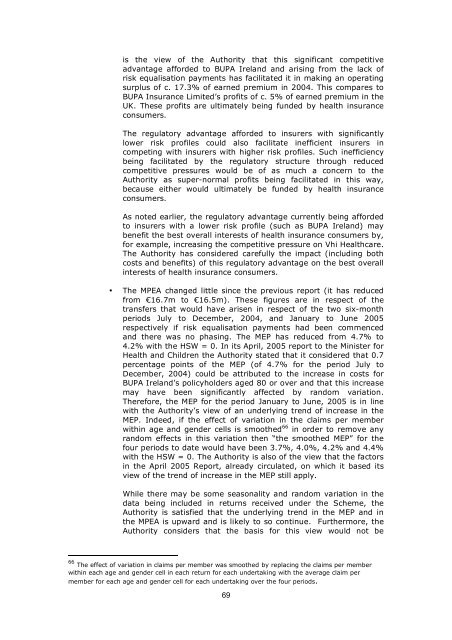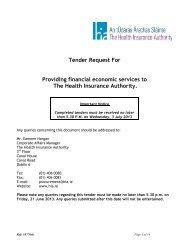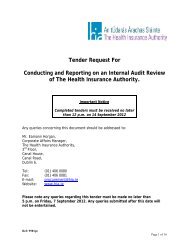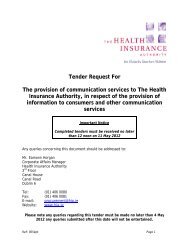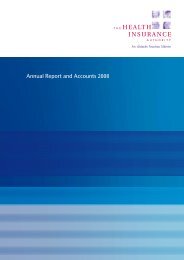Competition in the Irish Private Health Insurance Market
Competition in the Irish Private Health Insurance Market
Competition in the Irish Private Health Insurance Market
You also want an ePaper? Increase the reach of your titles
YUMPU automatically turns print PDFs into web optimized ePapers that Google loves.
is <strong>the</strong> view of <strong>the</strong> Authority that this significant competitive<br />
advantage afforded to BUPA Ireland and aris<strong>in</strong>g from <strong>the</strong> lack of<br />
risk equalisation payments has facilitated it <strong>in</strong> mak<strong>in</strong>g an operat<strong>in</strong>g<br />
surplus of c. 17.3% of earned premium <strong>in</strong> 2004. This compares to<br />
BUPA <strong>Insurance</strong> Limited’s profits of c. 5% of earned premium <strong>in</strong> <strong>the</strong><br />
UK. These profits are ultimately be<strong>in</strong>g funded by health <strong>in</strong>surance<br />
consumers.<br />
The regulatory advantage afforded to <strong>in</strong>surers with significantly<br />
lower risk profiles could also facilitate <strong>in</strong>efficient <strong>in</strong>surers <strong>in</strong><br />
compet<strong>in</strong>g with <strong>in</strong>surers with higher risk profiles. Such <strong>in</strong>efficiency<br />
be<strong>in</strong>g facilitated by <strong>the</strong> regulatory structure through reduced<br />
competitive pressures would be of as much a concern to <strong>the</strong><br />
Authority as super-normal profits be<strong>in</strong>g facilitated <strong>in</strong> this way,<br />
because ei<strong>the</strong>r would ultimately be funded by health <strong>in</strong>surance<br />
consumers.<br />
As noted earlier, <strong>the</strong> regulatory advantage currently be<strong>in</strong>g afforded<br />
to <strong>in</strong>surers with a lower risk profile (such as BUPA Ireland) may<br />
benefit <strong>the</strong> best overall <strong>in</strong>terests of health <strong>in</strong>surance consumers by,<br />
for example, <strong>in</strong>creas<strong>in</strong>g <strong>the</strong> competitive pressure on Vhi <strong>Health</strong>care.<br />
The Authority has considered carefully <strong>the</strong> impact (<strong>in</strong>clud<strong>in</strong>g both<br />
costs and benefits) of this regulatory advantage on <strong>the</strong> best overall<br />
<strong>in</strong>terests of health <strong>in</strong>surance consumers.<br />
• The MPEA changed little s<strong>in</strong>ce <strong>the</strong> previous report (it has reduced<br />
from €16.7m to €16.5m). These figures are <strong>in</strong> respect of <strong>the</strong><br />
transfers that would have arisen <strong>in</strong> respect of <strong>the</strong> two six-month<br />
periods July to December, 2004, and January to June 2005<br />
respectively if risk equalisation payments had been commenced<br />
and <strong>the</strong>re was no phas<strong>in</strong>g. The MEP has reduced from 4.7% to<br />
4.2% with <strong>the</strong> HSW = 0. In its April, 2005 report to <strong>the</strong> M<strong>in</strong>ister for<br />
<strong>Health</strong> and Children <strong>the</strong> Authority stated that it considered that 0.7<br />
percentage po<strong>in</strong>ts of <strong>the</strong> MEP (of 4.7% for <strong>the</strong> period July to<br />
December, 2004) could be attributed to <strong>the</strong> <strong>in</strong>crease <strong>in</strong> costs for<br />
BUPA Ireland’s policyholders aged 80 or over and that this <strong>in</strong>crease<br />
may have been significantly affected by random variation.<br />
Therefore, <strong>the</strong> MEP for <strong>the</strong> period January to June, 2005 is <strong>in</strong> l<strong>in</strong>e<br />
with <strong>the</strong> Authority’s view of an underly<strong>in</strong>g trend of <strong>in</strong>crease <strong>in</strong> <strong>the</strong><br />
MEP. Indeed, if <strong>the</strong> effect of variation <strong>in</strong> <strong>the</strong> claims per member<br />
with<strong>in</strong> age and gender cells is smoo<strong>the</strong>d 66 <strong>in</strong> order to remove any<br />
random effects <strong>in</strong> this variation <strong>the</strong>n “<strong>the</strong> smoo<strong>the</strong>d MEP” for <strong>the</strong><br />
four periods to date would have been 3.7%, 4.0%, 4.2% and 4.4%<br />
with <strong>the</strong> HSW = 0. The Authority is also of <strong>the</strong> view that <strong>the</strong> factors<br />
<strong>in</strong> <strong>the</strong> April 2005 Report, already circulated, on which it based its<br />
view of <strong>the</strong> trend of <strong>in</strong>crease <strong>in</strong> <strong>the</strong> MEP still apply.<br />
While <strong>the</strong>re may be some seasonality and random variation <strong>in</strong> <strong>the</strong><br />
data be<strong>in</strong>g <strong>in</strong>cluded <strong>in</strong> returns received under <strong>the</strong> Scheme, <strong>the</strong><br />
Authority is satisfied that <strong>the</strong> underly<strong>in</strong>g trend <strong>in</strong> <strong>the</strong> MEP and <strong>in</strong><br />
<strong>the</strong> MPEA is upward and is likely to so cont<strong>in</strong>ue. Fur<strong>the</strong>rmore, <strong>the</strong><br />
Authority considers that <strong>the</strong> basis for this view would not be<br />
66 The effect of variation <strong>in</strong> claims per member was smoo<strong>the</strong>d by replac<strong>in</strong>g <strong>the</strong> claims per member<br />
with<strong>in</strong> each age and gender cell <strong>in</strong> each return for each undertak<strong>in</strong>g with <strong>the</strong> average claim per<br />
member for each age and gender cell for each undertak<strong>in</strong>g over <strong>the</strong> four periods.<br />
69


